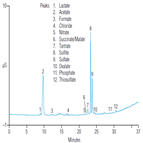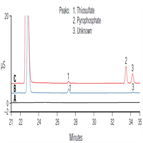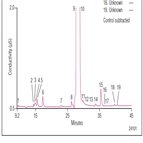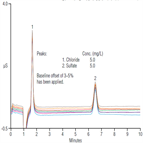Find methods for your needs
Refine by Feature
Displaying 1-5 of 7 results for Tag: thiosulfate
AB105: Anions and Organic Acids in Wood Extracts
Instrument Type: ICThis application demonstrates the analysis of inorganic anions and anions of organic acids in waste liquor from wood extracts. The sample matrix and the contaminant were removed from the components of interest using an IonPac NG1 column as an additional guard column. This application requires an autosampler equipped with 10-port valve. With this configuration, IonPac NG1 column is placed in line with the analytical column, while a second column rinsed in counter flow direction with acetonitrile/water, followed by a conditioning step using sodium hydroxide.
AN1088: Determination of Thiosulfate and Pyrophosphate in Crayfish Wash Powder
Instrument Type: ICMSTo make crayfish look more attractive to consumers, they are often cleaned with wash powder, and it is this wash powder that is suspected of causing the problems associated with excessive ingestion of crayfish. The reported harmful ingredients of crayfish wash powder are thiosulfate and phosphaterelated compounds. IC/MS was applied to the analysis of components in crayfish wash powder and an effective method was developed using the Thermo Scientific Dionex ICS-4000 Integrated Capillary HPIC System and the Thermo Scientific TSQ Vantage Triple Stage Quadrupole mass spectrometer.
AU159: Determination of Volcanic Gases as Anions in Caustic Solutions Using AutoNeutralization, Automated Dilutions, and a Reagent-Free Ion Chromatography System
Instrument Type: ICThe type, amount, and ratios of volcanic gases characterize and can predict impending volcanic activity and its intensity. Changes in CO2 concentration, SO2-CO2 ratios, or halide gas composition may indicate impending volcanic eruptions. Previous analyses indicate that volcanic gases are primarily composed of CO2, water vapor, and SO2 with trace amounts of arsine and halide gases. The samples are diluted by AutoDilution to determine the major components as anions and neutralized by AutoNeutralization to determine the trace gases as anions.
TN122: Separation of Heat Stable Amine Salts in Methyldiethanolamine (MDEA) SolutionsUsing High-Pressure IC
Instrument Type: ICSour gas is treated with amine and recycled amine (scrubbing) solutions to absorb toxic and undesirable H2S and CO2 create sweet natural gas. Salts of organic acids and sulfur species, heat stable amine salts (HSAS) can concentrate over time. Analysis of these HSAS are needed to assess the efficiency of scrubbing solution and can be quite challenging. In this technical note, HSAS in methyldiethanolamine (MDEA) were separated with high efficiency on a 2 mm i.d. IonPac AS11HC-4μm column using a high pressure ion chromatography system.
AN290: Determination of Total and Potential Sulfate and Total Chloride in Ethanol According to ASTM Method D 7319
Instrument Type: ICWhen combined with gasoline, ethanol increases octane levels and promotes better fuel burning. However, ethanol can be contaminated with chloride and sulfate, which can contribute to plugging and corrosion of automobile engines. This study describes a simple and direct injection IC method to determine total and potential sulfate and chloride in ethanol used as a gasoline additive. This method is consistent with ASTM method D 7319, which is intended for the analysis of ethanol samples containing 1.0–20.0 mg/L of total or potential sulfate and 1.0–50.0 mg/L of chloride.





